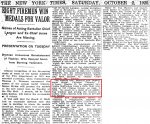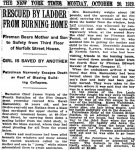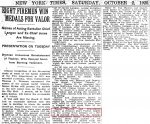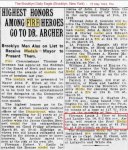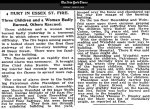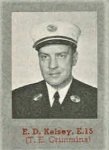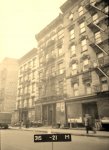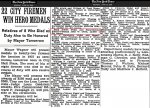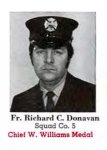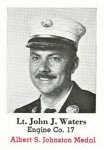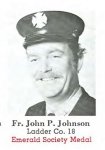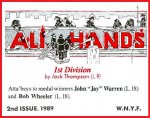ENGINE 15/LADDER 18/BATTALION 4 (ENGINE 17 DISBANDED) FIREHOUSE 25 PITT STREET LOWER EAST SIDE, MANHATTAN DIVISION 1, BATTALION 4 "FORT PITT"
LADDER 18 MEDALS
ALBERT J. GONZALEZ FF. LAD. 18 JAN. 16, 1992 1993 JAMES GORDON BENNETT
ALBERT J. GONZALEZ FF. LAD. 18 JAN. 16, 1992 1993 NYS HONORARY FIRE CHIEF

 200 EAST 7TH STREET, MANHATTAN
200 EAST 7TH STREET, MANHATTAN
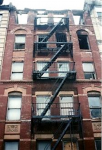
On the night tour of January 16, 1992 at 0003 hours, FDNY units were dispatched to Box 432 for a reported fire on the 5th floor of 200 East 7th Street, between Avenue B and Avenue C. While units were responding, the Manhattan Fire Dispatcher advised Battalion Chief Richard Rittmeyer of the 4th Battalion that 3 Engines, 3 Ladders, and the Rescue were responding to this fire due to numerous phone calls.
Engine 28 arrived 1st due. Nothing was visible in the front of the building. There was a wind blowing from front to rear. However, there was a strong odor of smoke and evacuating people told Captain Vinny Romeo E-28 that there was a fire upstairs. Captain Romeo transmitted a 10-75 at 0007 hours.
Captain Romeo E-28 made his way to the 5th floor and fire was already in the hallway. Engine 28 started a “well-hole” stretch by themselves. The stretch was efficient and rapid. Ladder 11 was the first due truck. Their forcible entry team went to the 5th floor as well. Ladder 18 was the 2nd due truck. Lieutenant Dan Butler, Fr. Al Gonzalez, and Fr. Pat McKenna (L-45 Det.) comprised the forcible entry team. As Ladder 18 was climbing the stairs, an evacuating person told Lieut. Butler that there were people on the top floor.
Fr. Ted Jankowski was the OV Firefighter for Ladder 11. Upon arrival, he went to the rear of the building. When he got to the rear yard, he saw fire coming out of every rear window on the 5th and 6th floors. He dropped the fire escape drop ladder and returned to the front of the building to bring the saw to the roof.
As Lieut. Butler L-18 arrived at the 5th floor, Capt. Romeo E-28 told Lieut. Butler that they didn’t have water yet. Lieut. Butler decided to go above the fire, possibly thinking that there were people trapped on the top (6th) floor. Ladder 18 made their way past the fire which was venting upward towards the stairway.

Fire was now venting heavily into the hallway of the 5th floor. Engine 28 got water and they started their advance into the rear apartments. Ladder 18’s Forcible Entry Team began forcing entry to the rear apartment which was directly over the fire. The fire had already extended to the 6th floor and this floor was getting hotter by the second. Their efforts were thwarted on the first door they tried because it was nailed shut. There was little space for them to operate. In their frantic efforts to force entry into the adjoining rear door, both Lieut. Butler and Fr. Gonzalez lost their helmets. The heat became unbearable for the members on the top floor. Conditions were worsening rapidly. Suddenly, the ceiling in the hallway on the top floor lit up. Ladder 18’s forcible entry team was in dire straits. They were being burned in the hallway on the floor above at this rapidly expanding fire.
(Historical Note: In 1992, The Personal Protective Equipment was Turnout Coat, Pull up Boots, and a Helmet. The SCBA was a Scott 4.5. Bunker gear was not standard equipment until after the Watts Street fire which occurred on March 28, 1994. That fire claimed the lives of Captain John Drennan L-5, Fr. Chris Siedenburg E-24, and Fr. James Young E-24.)
At the roof, heavy fire was venting out of the stairway bulkhead, over the parapet of the air and light shafts and over the rear parapet. Fr. Bob Annunziato L-11 (Roof Firefighter) and Fr. Pat Mulligan L-18 (Roof Firefighter) were cutting with the saw while Fr. Jankowski L-11 (OV), Fr. Gary Bulger L-18 (OV) conducted vertical ventilation.
On the floor above the fire (6th floor), it was now a fight for survival. The members of Ladder 18’s forcible entry team were scrambling to find a way out of their predicament. Under extreme heat, Fr. Gonzalez positioned himself at the front apartment door. He was able to force open the front apartment door and guide the members of L-18’s forcible entry team into the safety of the front apartment. All three members were burned. They made their way through the front apartment, to the front fire escape, and down to the street. Members operating inside the building didn’t know that L-18’s forcible entry team made their way to the fire escape.
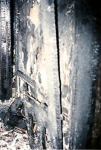
Engine 5 was the second due engine. They were having difficulty stretching the 2nd hose line. Fire was now rapidly expanding on the top floor.
Deputy Chief David Corcoran 1st Division arrived at the fire. He received a briefing from B.C. Rittmeyer Bn. 4. D.C. Corcoran sent B.C. Rittmeyer to supervise operations on the fire floor. B.C. Rittmeyer made it to the 5th floor and he called for another hose line. Engine 28 was ordered to re-position their hose line to the top floor to try to gain control of the fire there after they gave the fire on the 5th floor a quick hit with the hose stream. Ladder 9 went to the top floor as well. After crawling on the floor of the top floor, they found a burned helmet, Lieut. Butler’s helmet. The discovery of a Firefighter’s helmet is a universal indicator that a member is in distress.

Rescue 1 arrived on the top floor. They were commanded by Lieutenant Patrick (Paddy) Brown. He made a search of the hallway of the top floor. Thinking a Firefighter was still missing due to the discovery of the burned helmet, he was searching under extreme conditions. The fire was advancing enough that D.C. Corcoran was telling B.C. Rittmeyer that he wanted to change strategy and start using Tower Ladders. B.C. Rittmeyer told D.C. Corcoran that we have missing members and to hold off on using the Tower Ladder. B.C. Rittmeyer made his way to the top floor and told Lieut. Brown that he had to back down to the 5th floor. Lieut. Brown argued to stay on the top floor to search for the missing members. Both B.C. Rittmeyer Bn. 4 and Lieut. Brown R-1 were on their stomachs to try to avoid the intense heat as they searched.
Battalion Chief Peter Rice of Battalion 6 was on the roof supervising operations at this critical sector. B.C. Rice hearing on the radio that Lieut. Butler L-18 was missing, grabbed Fr. Gary Bulger, the OV from L-18. He told him that they cannot find his officer on the top floor.
Engine 5’s hose line made it to the top floor and the line was charged. Engine 28 was then able to drop back down to the original fire floor and continue their extinguishing efforts there.
The Forcible Entry team of Ladder 18 made their way to the ambulance for treatment. Word was finally transmitted over the handi-talkie that the missing members were accounted for. The search for the missing members was suspended.
Deputy Chief David Corcoran transmitted a 2nd alarm at 0019 and a 3rd alarm at 0028 hours. Hose lines were stretched to exposures 2 and 4 to attack the fire in the rear of the building.
FDNY units operated at this box for 5 hours. Lieutenant Dan Butler, Firefighter Patrick McKenna and Firefighter Al Gonzalez were all taken to the Cornell Burn Center. Firefighter Al Gonzalez was awarded a Class I award, the James Gordon Bennett Medal and the Dr. Harry M. Archer Medal for his actions on January 16, 1992.
 Thanks to D.C. Richard Rittmeyer (Ret.), D.C. Ted Jankowski (Ret.), Capt. Vincent Romeo (Ret.), Lieut. Albert Gonzalez (Ret.), Fr. Pat McKenna (Ret.), Fr. Bob Athanis R-3, Fr. Chris Roberto E-48, Fr. Gary Bulger L-18 and D.C. Vincent Dunn (Ret.) for their contributions to this essay.
Deputy Chief Jay Jonas, Division 7
Division 7 Newsletters | Firefighter Close Calls
Thanks to D.C. Richard Rittmeyer (Ret.), D.C. Ted Jankowski (Ret.), Capt. Vincent Romeo (Ret.), Lieut. Albert Gonzalez (Ret.), Fr. Pat McKenna (Ret.), Fr. Bob Athanis R-3, Fr. Chris Roberto E-48, Fr. Gary Bulger L-18 and D.C. Vincent Dunn (Ret.) for their contributions to this essay.
Deputy Chief Jay Jonas, Division 7
Division 7 Newsletters | Firefighter Close Calls

